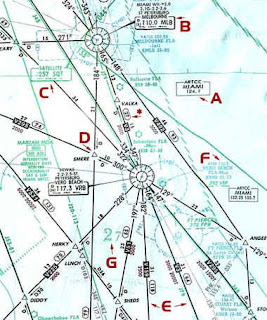This week is a short week, since we get Thursday off for Thanksgiving, which is nice!
Monday & Tuesday: We Continued our lessons on VFR/IFR charts, which is essentially re-learning how to read a map, designed for aviation. Under VFR (Visual Flight Rules) and IFR (Instrument Flight Rules), there are several different types of charts that a pilot can use. There are the Terminal or area charts, which show the most detail. These are for use in populated/congested area with lots of traffic. This would be analogous to the map of New York City within the state map of NY. Then there are VFR Sectional charts & VFR World Charts, which have a larger scale, so they have less detail. These are for use by slightly faster aircraft, but still in VFR conditionsl. For IFR (beyond the terminal Area), there are Low & High En Route charts. Under IFR conditions, a pilot doesn't need to look out the window for navigation, so these charts don't have as many details (ie. obstructions, landmarks etc.). Instead, they display the proverbial "Highways in the sky". Below are examples of a VFR Sectional Chart and an En Route IFR Chart:


Wednesday: Our lessons on charts continued, however we moved to different types of Charts: STARs, SIDs, and Approaches. A STAR (Standard Termainal Arrival) is a published procedure that allows the standardized approach into the vicinity of an airport from high altitudes (en route). For example, those of you who live near Annapolis or Eastern Shore, you may always notice that the planes fly over your house at almost the exact same place and same altitude, one after another. This is because they are established on a published STAR, that is designed for the Baltimore area (if you really want to look it up, this is a link to the procedure: http://204.108.4.16/d-tpp/0912/00804RAVNN.PDF).
The next type of chart is the SID (Standard Instrument Departure), and SIDs serve a similar purpose as STARs, except they are deisgned for departures from an airport. For example, since we have 3-4 major airports in the DC area, you obviously can't have flights just flying wherever they want to! So instead, there are published procedures that guide you from the Terminal Environment (Airport) to the en route Environment (Cruising altitude). For any of you who fly out of Baltimore --If you are flying South or Southwest of Baltimore, then I can almost guarentee that your flight will take you: Over Columbia, North of DC/Gaithersburg, turn and then take a turn towards Dulles Airport before establishing on your flight. Here's a map of that procedure: http://204.108.4.16/d-tpp/0912/00804TERPZ.PDF. These procedures allow for more safety, efficiency, and can also reduce the workload for pilots/controllers.
The final type of chart we learned is an Instrument Approach Procedure (IAP): These are designed to allow the pilot to navigate directly to the runway in IFR conditions. The most commonly used for Commerical Airliners is called the ILS Approach (Instrument Landing System). An IAP will allow a pilot to tune into a navigational aid (ie. Radio beacon), and use that to fly directly to the airport, and there are two types: Precision and Non-Precision. Precision means that the Nav-Aid provides lateral and vertical guidance, and I'll explain: The instrument display shows the pilot exactly how far above/below the course he is, and it also shows how far left/right of course. So if you've ever heard a pilot tell you that the airplane can "land itself", that's really true, and its because of the precision approach. Non Precision approaches provide only lateral guidance, and because they aren't as precise (hence the name), you cannot fly as low in IFR conditions. Ask me if you want to learn more about this --I don't want to type out how everything works!! Its very interesting stuff though!
Thursday: Day off!! Happy Thanksgiving! We hosted a huge feast at my house, and it was a great success. I cooked almost everything, but my roomates were clutch with cooking the big meat (that's what she said?). We had Turkey, Ham, Stuffing, Carrots, Mashed Potatos/Gravy, Green Bean Casserole, Sweet Potatos, Chess Pie, Pecan Pie, and rolls. Mmm...delicious. Too bad we didn't have Friday off.
Friday: Today was a pretty big waste anyway --All non-ATC personnel took the day off, so the Academy was pretty empty...We were way ahead of schedule, so we had breaks almost every 30 minutes, which was nice. We had one lesson left in the block, which was "Pilots Environment." This lesson taught the basics of airplane systems and navigation. We finished the day with a review (our next block test is on Monday), and then went home for the weekend!!

No comments:
Post a Comment